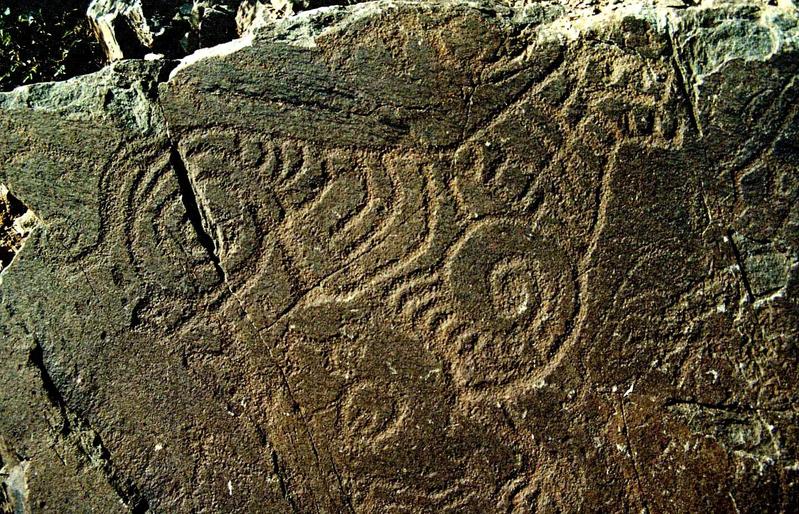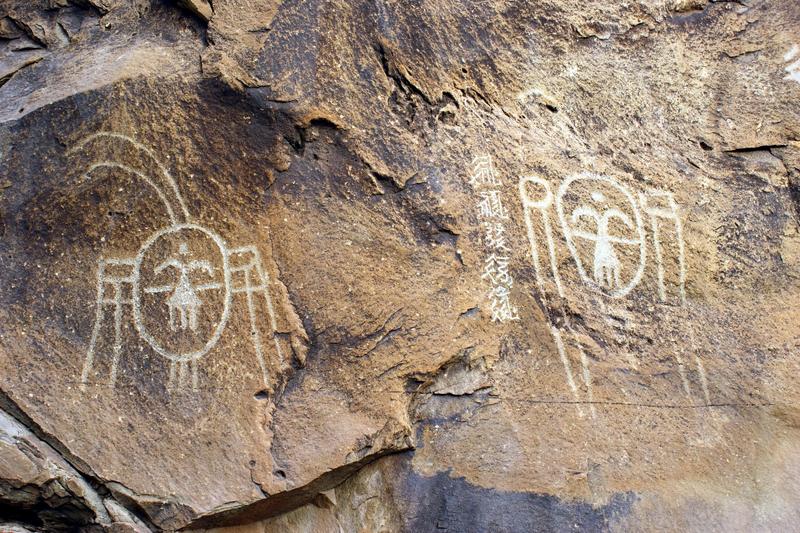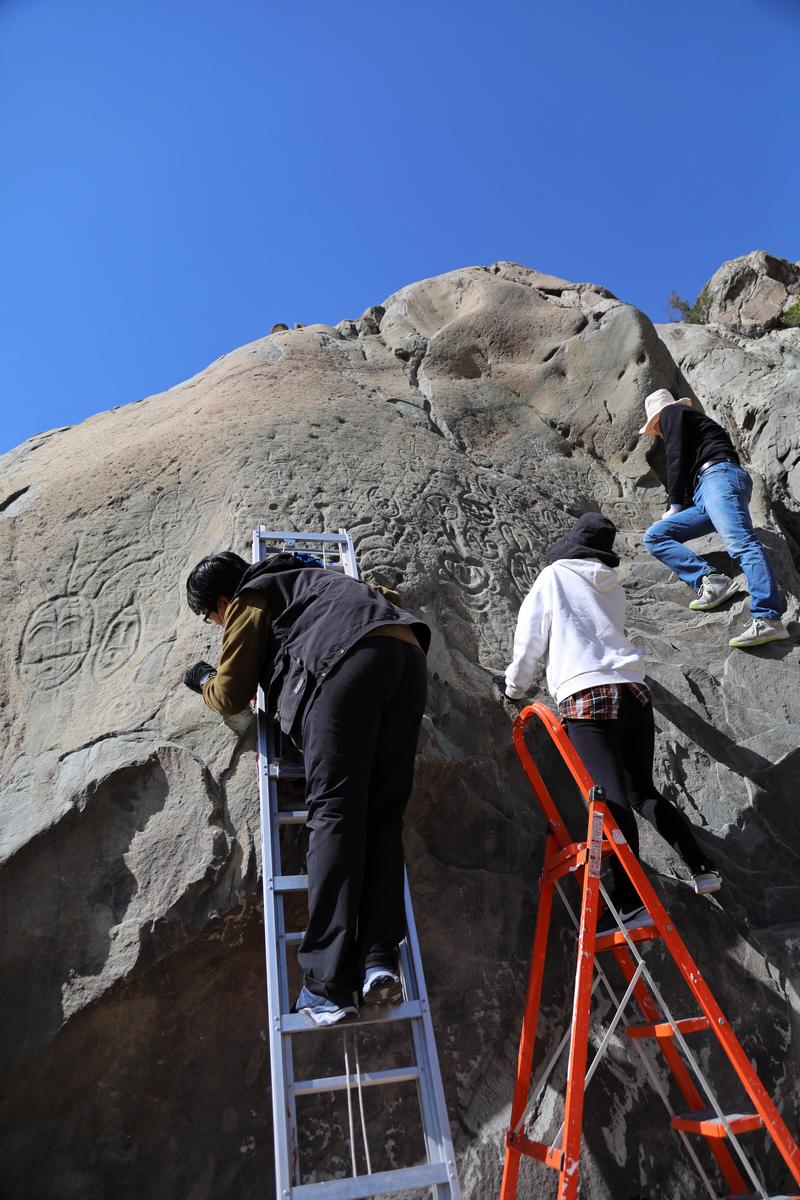Fascinating rock carvings offer an intriguing insight into ancestors and origins, Deng Zhangyu and Hu Dongmei report.
 (SONG CHEN / CHINA DAILY)
(SONG CHEN / CHINA DAILY)
Walking in the park of Helanshan Rock Art Relics in Yinchuan, Ningxia Hui autonomous region, is like taking a stroll through history. One can't help but marvel and be fascinated at the number of artworks and carvings engraved on the rocks at the entrance to the Helan Mountains. These motifs and patterns, painted or carved, were an encyclopedia of knowledge before human beings knew how to read or write. And today they help us understand how our ancestors lived.
Rock carvings in the park cover a wide range of subjects that vividly depict the life and sacrificial rituals of people who lived there between 10,000 and 3,000 years ago, says Zhang Jianguo, an expert on rock art and deputy director of the Helan Mountains rock art management bureau.
These imaginative patterns reveal a rich spiritual world of humans living in the past. They were poor in material resources, but rich in spirituality.
Zhang Jianguo, expert on rock art
Altogether, about 6,000 carvings have been found in the park area since the 1970s. And in the Helan Mountains region, more than 25,000 pieces have been discovered.
"Rock art has been widely discovered in many places across China," says Zhang. "But the relic park is the only place that has so many rock art pieces in one site. And the content covers all subjects of rock art, including animals, plants, figurines, hunting, production and belief."
This enables visitors to get a comprehensive glimpse into prehistoric art, perhaps in a trip of just one or two hours. In other places, visitors often have to drive or walk long distances to find such remnants.
According to Zhang, the "histories on rock" were a kind of fashionable way for humans to express their spiritual world before words and characters were created. This is true the world over, he points out.
"Motifs and patterns found in different continents share a kind of surprising similarity in terms of subjects and the way they are expressed. From this point of view, rock art can be seen as a universal language of the Stone Age," Zhang says.
 Rock carvings found in the Helan Mountains cover a wide range of subjects, such as (from left) animals, the sun god and human faces. (PHOTO PROVIDED TO CHINA DAILY)
Rock carvings found in the Helan Mountains cover a wide range of subjects, such as (from left) animals, the sun god and human faces. (PHOTO PROVIDED TO CHINA DAILY)
 Rock carvings found in the Helan Mountains cover a wide range of subjects, such as (from left) animals, the sun god and human faces. (PHOTO PROVIDED TO CHINA DAILY)
Rock carvings found in the Helan Mountains cover a wide range of subjects, such as (from left) animals, the sun god and human faces. (PHOTO PROVIDED TO CHINA DAILY)
 Rock carvings found in the Helan Mountains cover a wide range of subjects, such as (from left) animals, the sun god and human faces. (PHOTO PROVIDED TO CHINA DAILY)
Rock carvings found in the Helan Mountains cover a wide range of subjects, such as (from left) animals, the sun god and human faces. (PHOTO PROVIDED TO CHINA DAILY)
For instance, images to symbolize shamans found in the area look like abstract lines of frogs. Similar patterns were also discovered in a number of other countries.
"It was common in prehistoric times to regard frogs as divine animals due to their fertility and their ability to live both on land and in water," Zhang explains.
The highlight of the rock art in the Helan Mountains is undoubtedly the human faces carved on rocks, a feature that is rare in other places. There are about 700 carvings of faces. The iconic petroglyph is the sun god. Its positioning was significant. Carved on a steep rock, it gazes down from about 20 meters high, signaling its superpower.
The eyes of the sun god are represented by two concentric circles, with rays emanating from its head.
"It's a very mysterious pattern and exquisitely engraved. It's unique among all the motifs found across the world," says Zhang, adding that it's a mix of the human face and a deity.
 An aerial view of the park of Helanshan Rock Art Relics in Yinchuan, Ningxia Hui autonomous region. (PHOTO PROVIDED TO CHINA DAILY)
An aerial view of the park of Helanshan Rock Art Relics in Yinchuan, Ningxia Hui autonomous region. (PHOTO PROVIDED TO CHINA DAILY)
According to Zhang's research, human faces engraved on rocks there are classified into various groups, including ancestral, totem, mask, fertility and deity worship.
The faces also reveal a very early sacrificial culture. Most of the images of the human and deity faces were engraved on rocks standing along the valley.
Zhang explains that the river winding through the mountains proves that people gathered and lived in the area. Besides, it was convenient for them to hold rituals around a rock carving that was near the valley instead of high on the mountain.
The patterns of the faces are interesting and sometimes hard to explain, such as a face with one eye open and one eye shut. Another face has 13 petals surrounding the head to symbolize the power of women and one face has sheep in the eyes.
"These imaginative patterns reveal a rich spiritual world of humans living in the past. They were poor in material resources, but rich in spirituality. Many motifs still need more research for us to decode," says Zhang, who has been devoted to the research of rock art since he graduated from university 20 years ago.
 Researchers engage in the study of the carvings engraved on cliffs at the park. (PHOTO PROVIDED TO CHINA DAILY)
Researchers engage in the study of the carvings engraved on cliffs at the park. (PHOTO PROVIDED TO CHINA DAILY)
For the past few decades, Zhang and his team have consistently identified rock art pieces in the vast and jagged mountainous areas. It is challenging work, both physically and mentally.
"Sometimes, we spend a whole day searching for rock art and end up finding nothing. Sometimes, we are lucky to find one but still have to spend a lot of time to figure out the exact pattern," Zhang says, adding that the lines on the rock are hard to recognize because of weathering.
Since the 1970s, when rock art was found in the Helan Mountains, experts and the local government have tried their best to protect it.
Chen Zhaofu, an expert who established the first rock art research center in China, helped to organize two annual meetings of the International Rock Engraving Committee of UNESCO in 1991 and 2000 in Yinchuan.
In 2002, the management bureau of rock art in the Helan Mountains was set up and later a regulation on protection of rock art was issued by the local government. In 2014, the Yinchuan World Rock Art Museum opened to the public, the first of its kind in China, to raise people's awareness of the need to protect rock carvings.
Now, Zhang and his team are using modern technology to find new carvings. To better protect discovered items, they also cooperate with universities, museums and artistic organizations.
"Rock art is a great epic engraved on rocks," Chen wrote in 2014 when the rock art museum was established. "Through this kind of art form, we can find out the substance of human nature: knowledge, culture, art, imagination and religion."
But questions remain about the origins of the human journey. Slowly and with painstaking research, they are being answered but new questions stem from such discoveries.
Contact the writers at dengzhangyu@chinadaily.com.cn


